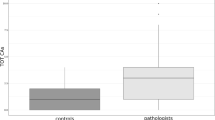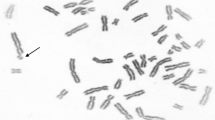Abstract
The formaldehyde (FA) genotoxic potential in occupationally exposed individuals is conflicting. A relevant indoor-air FA pollution was found in hospitals and scientific institutions where FA is used as a bactericide and tissue preservative. In the present study, we evaluated the frequency of chromosomal aberrations (CAs) in peripheral blood lymphocytes from workers in pathology wards who have been exposed to FA, compared with a group of unexposed subjects. The subjects were also analyzed for the GSTM1 and GSTT1 metabolic gene polymorphisms. The exposed subjects showed a significant increase in the frequency of CA per cell and in the percentage of cells with aberrations compared to control subjects. The different GST genotypes did not affect the level of cytogenetic damage since CA frequencies were not statistically different between the GST “null” genotypes and the GST “positives”. The generalized linear models showed that the number of CAs and cells with CAs increased with age, but, independent of age, it was significantly higher in the experimental rather than in the control group. Cubic-spline regression confirmed the linear relationship between CAs and age, but it provided evidence for a non-linear relationship between CAs and the number of years of FA exposure. Similar results were observed when the model included the number of cells with CAs as dependent variables. Our results demonstrate that air FA induces CAs even consequently to low levels of daily exposure, indicating an increased risk of genetic damage for workers exposed to this air pollutant.


Similar content being viewed by others
References
Alzueta MU, Glarborg P (2003) Formation and destruction of CH2O in the exhaust system of a gas engine. Environ Sci Technol 37:4512–4516
Bauchinger M, Schmid E (1985) Cytogenetic effects in lymphocytes of formaldehyde workers of a paper factory. Mutat Res 158:195–199
Bernardini S, Hirvonen A, Jarventaus H, Norppa H (2002) Influence of GSTM1 and GSTT1 genotypes on sister chromatid exchange induction by styrene in cultured human lymphocytes. Carcinogenesis 23:893–897
Bolognesi C, Abbondandolo A, Barale R, Casalone R, Dalprà L, De Ferrari M, Degrassi F, Forni A, Lamberti L, Lando C, Migliore L, Padovani P, Pasquini R, Puntoni R, Sbrana I, Stella M, Bonassi S (1997) Age-related increase of baseline frequencies of sister chromatid exchanges, chromosome aberrations, and micronuclei in human lymphocytes. Cancer Epidemiol Biomarkers Prev 6(4):249–256
Bono R, Degan R, Pazzi M, Romanazzi V, Rovere R (2010a) Benzene and formaldehyde in air of two Winter Olympic venues of “Torino 2006”. Environ Int 36(3):269–275
Bono R, Romanazzi V, Munnia A, Piro S, Allione A, Ricceri F, Guarrera S, Pignata C, Matullo G, Wang P, Giese RW, Peluso M (2010b) Malondialdehyde-Deoxyguanosine Adduct Formation in Workers of Pathology Wards: The Role of Air Formaldehyde Exposure. Chem Res Toxicol 23(8):1342–1348
Burgaz S, Cakmak G, Erdem O, Yilmaz M, Karakaya AE (2001) Micronuclei frequencies in exfoliated nasal mucosa cells from pathology and anatomy laboratory workers exposed to formaldehyde. Neoplasma 48:144–147
Celik M, Donbak L, Unal F, Yüzbasioglu D, Aksoy H, Yilmaz S (2007) Cytogenetic damage in workers from a coal-fired power plant. Mutat Res 627:158–163
Costa S, Coelho P, Costa C, Silva S, Mayan O, Santos LS, Gaspar J, Teixeira JP (2008) Genotoxic damage in pathology anatomy laboratory workers exposed to formaldehyde. Toxicology 252(1–3):40–48
Crawley MJ (2005) Statistics: an introduction using R. Wiley, London
Faraway JJ (2006) Extending the linear model with R: Generalized linear. Mixed effects and Nonparametric regression models. Chapman & Hall, London
Hauptmann M, Stewart PA, Lubin JH, Beane Freeman LE, Hornung RW, Herrick RF, Hoover RN, Fraumeni JF, Blair A, Hayes RB (2009) Mortality from lymphohematopoietic malignancies and brain cancer among embalmers exposed to formaldehyde. J Natl Cancer Inst 101(24):1696–1708
International Agency for Research on Cancer (IARC) (1995) Wood dust and formaldehyde. IARC Monogr Eval Carcinog Risks Hum 62:217–375
International Agency for Research on Cancer (IARC) (2006) Formaldehyde, 2-butoxyethanol and 1-tert-butoxypropan-2-ol. Lyon. IARC Monogr Eval Carcinog Risks Hum 88:1–478
IPCS (1989) Formaldehyde, Environmental Health Criteria. World Health Organization, Geneva 89:11–176
Jakab MG, Klupp T, Besenyei K, Biro A, Major J, Tompa A (2010) Formaldehyde-induced chromosomal aberrations and apoptosis in peripheral blood lymphocytes of personnel working in pathology departments. Mutat Res 698:11–17
Jiang S, Yu L, Cheng J, Leng S, Dai Y, Zhang Y, Niu Y, Yan H, Qu W, Zhang C, Zhang K, Yang R, Zhou L, Zheng Y (2010) Genomic damages in peripheral blood lymphocytes and association with polymorphisms of three glutathione S-transferases in workers exposed to formaldehyde. Mutat Res 695(1–2):9–15
Kurose T, Kodera H, Aoyama H, Kawamata S (2004) Formaldehyde concentration in the air and in cadavers at the gross anatomy laboratory in Hiroshima University. Hiroshima J Med Sci 53:33–37
Laforest L, Luce D, Goldberg P, Bégin D, Gérin M, Demers PA, Brugère J, Leclerc A (2000) Laryngeal and hypopharyngeal cancers and occupational exposure to formaldehyde and various dusts: a case-control study in France. Occup Environ Med 57:767–773
Marcsek ZL, Kocsis Z, Szende B, Tompa A (2007) Effect of formaldehyde and resveratrol on the viability of Vero, HepG2 and MCF-7 cells. Cell Biol Int 31:1214–1219
Marsh GM, Youk AO, Buchanich JM, Cassidy LD, Lucas LJ, Esmen NA, Gathuru IM (2002) Pharyngeal cancer mortality among chemical plant workers exposed to formaldehyde. Toxicol Ind Health 18:257–268
Pala M, Ugolini D, Ceppi M, Rizzo F, Maiorana L, Bolognesi C, Schilirò T, Gilli G, Bigatti P, Bono R, Vecchio D (2008) Occupational exposure to formaldehyde and biological monitoring of Research Institute workers. Cancer Detect Prev 32:121–126
Pemble S, Schroeder KR, Spenser SR, Meyer DJ, Hallier E, Bolt HM, Ketterer B, Taylor JB (1994) Human glutathione-S-transferase theta (GSTT1): cDNA cloning and the characterization of a genetic polymorphism. Biochem J 300:271–276
Perera FP (2000) Molecular epidemiology: on the path to prevention? J Natl Cancer Inst 92:602–612
Pinkerton LE, Hein MJ, Stayner LT (2004) Mortality among a cohort of garment workers exposed to formaldehyde: an update. Occup Environ Med 61:193–200
R-DevelopmentCore Team (2007) R: A Language and Environment for Statistical Computing. R Foundation for Statistical Computing, Vienna
Rossi AM, Hansteen IL, Skjelbred CF, Ballardin M, Maggini V, Murgia E, Tomei A, Viarengo P, Knudsen LE, Barale R, Norppa H, Bonassi S (2009) Association between frequency of chromosomal aberrations and cancer risk is not influenced by genetic polymorphisms in GSTM1 and GSTT1. Environ Health Perspect 117(2):203–208
Shaham J, Gurvich R, Kaufman Z (2002) Sister chromatid exchange in pathology staff occupationally exposed to formaldehyde. Mutat Res 514:115–123
Shaham J, Bomstein Y, Gurvich R, Rashkovsky M, Kaufman Z (2003) DNA–protein crosslinks and p53 protein expression in relation to occupational exposure to formaldehyde. Occup Environ Med 60:403–409
Silva MC, Gaspar J, Duarte Silva I, Faber A, Rueff J (2004) GSTM1, GSTT1, and GSTP1 genotypes and the genotoxicity of hydroquinone in human lymphocytes. Environ Mol Mutagen 43(4):258–264
Spengler JD, Sexton K (1983) Indoor air pollutants: a public health perspective. Science 221(4605):9–17
The National Institute for Occupational Safety and Health (NIOSH) (2003) Formaldehyde: method 2016. NIOSH Manual of Analytical Methods (NMAM), Fourth Edition, 2, 1-7 Washington, DC (U.S.)
Thomson EJ, Shackleton S, Harrington JM (1984) Chromosome aberrations and sister chromatid exchange frequencies in pathology staff occupationally exposed to formaldehyde. Mutat Res 141:89–93
Trézl L, Hullán L, Jászay ZM, Szarvas T, Petneházy I, Szende B, Bocsi J, Takáts Z, Vékey K, Töke L (2003) Antagonistic reactions of arginine and lysine against formaldehyde and their relation to cell proliferation, apoptosis, folate cycle and photosynthesis. Mol Cell Biochem 244(1–2):167–176
Tyihak E, Bocsi J, Timar F, Racz G, Szende B (2001) Formaldehyde promotes and inhibits the proliferation of cultured tumour and endothelial cells. Cell Prolif 34:135–141
Vodicka P, Naccarati A, Vodickova L, Polakova V, Dusinska M, Musak L, Halasova E, Susova S, Soucek P, Hemminki K (2009) Do GST polymorphisms modulate the frequency of chromosomal aberrations in healthy subjects? Environ Health Perspect 117(9):A384–A385
Walsh PS, Metzger DA, Higuchi R (1991) Chelex 100 as a Medium for simple extraction of DNA for PCR-based typing from forensic material. Biotechniques 10:506–513
Wojda A, Zietkiewicz E, Mossakowska M, Pawlowski W, Skrzypczak K, Witt M (2006) Correlation between the level of cytogenetic aberrations in cultured human lymphocytes and the age and gender of donors. J Gerontol A. Biol Sci Med Sci 61:763–772
Wu FY, Tsai FJ, Kuo HW, Tsai CH, Wu WY, Wang RY, Lai JS (2000) Cytogenetic study of workers exposed to chromium compounds. Mutat Res 464:289–296
Xu X, Wiencke JK, Niu T, Wang M, Watanabe H, Kelsey KT, Christiani DC (1998) Benzene exposure, glutathione S-transferase theta homozygous deletion, and sister chromatid exchanges. Am J Ind Med 33:157–163
Ye X, Yan W, Xie H, Zhao M, Ying C (2005) Cytogenetic analysis of nasal mucosa cells and lymphocytes from high-level long-term formaldehyde exposed workers and low-level short-term exposed waiters. Mutat Res 588(1):22–27
Yong LC, Schulte PA, Wiencke JK, Boeniger MF, Connally LB, Walker JT, Whelan EA, Ward EM (2001) Hemoglobin adducts and sister chromatid exchanges in hospital workers exposed to ethylene oxide: effects of glutathione S-transferase T1 and M1 genotypes. Cancer Epidemiol Biomarkers Prev 10:539–550
Zhang L, Steinmaus C, Eastmond DA, Xin XK, Smith MT (2009) Formaldehyde exposure and leukemia: a new meta-analysis and potential mechanisms. Mutat Res 681(2–3):150–168
Zhong S, Wyllie AH, Barnes D, Wolf CR, Spurr NK (1993) Relationship between the GSTM1 genetic polymorphism and susceptibility to bladder, breast and colon cancer. Carcinogenesis 14:1821–1824
Acknowledgments
This work was supported by grants from the Italian Ministry of University and Scientific Research and from Piedmont Region, Italy (Grants 2008). We are grateful to Natascha Rogge for her valuable help and criticism and to all volunteers who participated in this study as controls or as exposed.
Conflict of Interest
The authors declare that they have no conflict of interest.
Author information
Authors and Affiliations
Corresponding author
Rights and permissions
About this article
Cite this article
Santovito, A., Schilirò, T., Castellano, S. et al. Combined analysis of chromosomal aberrations and glutathione S-transferase M1 and T1 polymorphisms in pathologists occupationally exposed to formaldehyde. Arch Toxicol 85, 1295–1302 (2011). https://doi.org/10.1007/s00204-011-0668-3
Received:
Accepted:
Published:
Issue Date:
DOI: https://doi.org/10.1007/s00204-011-0668-3




